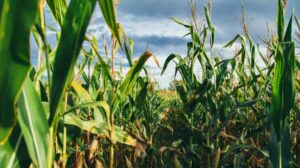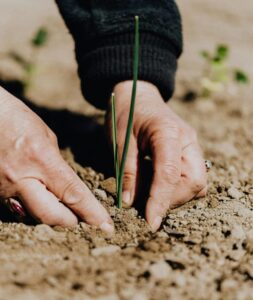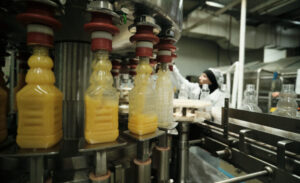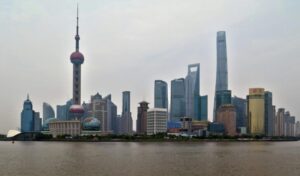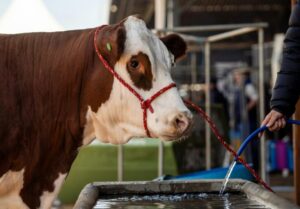Introduction
Table grapes are grapes intended for consumption while they are fresh, as opposed to grapes grown for wine production, juice production, or for drying into raisins. Table varieties usually have lower sugar content than wine grapes and are more flavourful when eaten. Their flavours, however, do not survive fermentation and their low sugar content means that any wine produced from them is weak, bland-tasting and easy to deteriorate.
Source: www.satgi.co.za; Table grape market value chain on www.nda.gov.za
International business environment
- The top producers of table grapes are China, and a distant second India, Turkey, Uzbekistan, and Egypt (USDA, 2025).
- The top exporters are Peru, China, Chile, India, and South Africa (USDA, 2025).
- The top importers are the US, EU, Russia, UK, and Canada (USDA, 2025).
FURTHER REFERENCE:
- Read the latest Overview Global Table Grape Market by Fresh Plaza at www.freshplaza.com
South Africa: import and export
- Table grapes exports from South Africa have gone to Europe (57%), UK (20%), Canada (6%), Middle East (4%), South East Asia (3%), Israel (2%), USA (2%), China & Hong Kong (2%), Russia (2%), the Indian Ocean islands (1%), and Africa (1%) (FPEF, 2025).
Local business environment
- The Orange River; the valleys of the Hex, Berg and Olifants Rivers; and Limpopo province are the main producers of table grapes (find the “Regions” option at www.satgi.co.za).
- Table and dry grapes are one of the most important deciduous fruit grown in South Africa, taking into consideration their foreign exchange earnings, employment creation and linkage with support institutions.
- Table grapes sold in the export markets generate a greater unit price than that achieved on the local market. For this reason, management orientation and understanding of the rules of the export markets are critical factors in the pathway to success in table grape production.
- Up to 90% of the total production is exported, mostly to Europe and the UK where South Africa enjoys preferential market access through the Trade Development and Cooperation Agreement (TDCA) between South Africa and the EU.
- The bulk of sales to the consumer are by means of contractual agreements via preferred category suppliers to the large supermarket chains. Furthermore, various export companies or agents conduct work on the basis of consignment sales on behalf of the growers or packers. The industry operates in a deregulated environment where prices are determined by the market forces of demand and supply.
Further reference:
- The reader is encouraged to visit www.satgi.co.za. The Statistics Book and other documents provide a comprehensive picture of the industry.
- The annual Bureau for Food and Agricultural Policy (BFAP) Baseline covers the table grape industry. Find the document at www.bfap.co.za.
- The Bureau for Food and Agricultural Policy (BFAP) Baseline 2024-2033 included “Box 2: Correlation between infrastructure failures and table grape claims”. This is an analysis showing that the performance at Cape Town port contributed to losses estimated at R4.7bn for the industry over a 5-year period.
- Also check whether the Directorate Marketing at the Department of Agriculture has resumed publishing the annual Table Grape Market Value Chain Profile on its webpages at www.nda.gov.za.
Transformation
Find the “Skills Development and Transformation” option at www.satgi.co.za.
- Hortfin is a R600 billion, special purpose development financing vehicle established by the deciduous, table grape and wine industries. The custodian of Hortfin is the deciduous fruit industry, supported by the Jobs fund and Land Bank. It targets mostly agri entrepreneurs from previously disadvantaged groups. Read more at www.hortgro.co.za/inclusive-growth/hortfin/.
National strategy and government contact
- Table grapes, citrus and vegetables are looked at in chapter 6 of the National Development Plan (NDP) as areas in which jobs can be created. It is an important crop for the country having high growth potential while being labour intensive (Sihlobo, 2018).
- Find details of the different directorates at the Department of Agriculture at www.nda.gov.za.
- The Perishable Products Exports Control Board (PPECB) acts for government in terms of the Agricultural Products Standards Act 119 of 1990 and controls and certifies that quality standards of these products are met. See https://ppecb.com.
Role players
View the Premium Listings below (scroll down or click on “Premium Listings” on the Table of Contents to the right).
Further reference:
Companies: exporters
- Find the list of table grape exporters in the FPEF Export Directory at https://fpef.co.za.
Training and research
The Table Grape Academy comprises the:
- Viticulture (Table Grape Science) lecturing post at Stellenbosch University.
- SATI/ARC/ Elsenburg Modular Course in Table Grape production.
- Audio Visual Materials and other training materials used by the industry for the industry.
- Various bursaries.
- Various training and mentorship programmes for emerging producers and middle managers.
The Modular Course in Table Grape Production is presented by SATI, ARC-Infruitec/Nietvoorbij and Elsenburg.
***
Developing skills and best practices for grape farmers in the Northern Cape
A long-term empowerment programme in the Northern Cape has helped previously disadvantaged farmers improve their grape farming knowledge and financial management skills. The project is an Agricultural Research Council (ARC) led collaboration between several government and non-governmental organisations, as well as two private companies in the fruit and wine industry. Since 1997, the project has offered farmers days, business management training courses, workshops, and on-farm consultations to the communities of Eksteenskuil and Releaboga. The project has resulted in many new wine and raisin grape vineyards being established.
Source: Agricultural Research Council (ARC)
Websites and publications
- Refer to websites listed earlier on this page e.g. www.satgi.co.za.
- The annual Fresh Fruit Exporter Directory gives trade statistics for the table grapes and other fruit sectors. Download it at the Fresh Produce Exporters’ Forum (FPEF) website, https://fpef.co.za.
- The annual Food Trade SA publication is another good source of export statistics for fresh produce. Find it at https://ppecb.com/documents
- Table grapes was previously covered in the Department of Agriculture annual publications on market value chains. Check to see if these are being published again on the Directorate Marketing web pages on www.nda.gov.za. The Abstract of Agricultural Statistics on the website includes statistics on grapes – production, sales on markets, exports, purchases for processing etc. The Department also has “Production guidelines: grapes” which can be downloaded under the “Publications” option on its website.
- The ARC-Infruitec/Nietvoorbij has a list of numerous publications on table grape production. This can be found on its pages at www.arc.agric.za. Also from them is series of full colour pamphlets discussing how to identify, control and prevent various diseases and pests in the vineyard.
- CD Roms from the ARC-Plant Health and Protection (PHP) include: Crop Pests, vol. 1: Deciduous Fruit, Grapes and Berries. Write to booksales [at] arc.agric.za or infopri [at] arc.agric.za.
- Consult the AgriSETA Learner Guide Primary Agriculture “Harvesting agricultural crops”.
- Farming.com. Available at www.africanfarming.com/fruit-production-get-right-rootstock-planting-grapes/
Some articles
- Reporter. 2025, June 12. “South Africa Breaks Records in Table Grape Exports and Increases Presence in the United States.” TRIDGE. Available at www.tridge.com/news/south-africa-breaks-records-in-table-grape-e-kmqfto
- Sihlobo W. 2025, May 30. “The South African table grapes stand out in uneven farming forecast.” Agricultural Economics Today. Available at https://wandilesihlobo.com/2025/05/30/the-south-african-table-grapes-stand-out-in-uneven-farming-forecast/
- Heijboer I. 2025, January 23. “‘Packaging in the field reduces handling, and we avoid spending millions on a packhouse'”. Fresh Plaza. Available at www.freshplaza.com/africa/article/9696847/packaging-in-the-field-reduces-handling-and-we-avoid-spending-millions-on-a-packhouse
- Staff Writer. 2025, January 22. “EU green deal could impact South African agricultural exports and jobs”. Fresh Plaza. Available at www.freshplaza.com/africa/article/9697876/eu-green-deal-could-impact-south-african-agricultural-exports-and-jobs
- Reporter. 2025, January 17. “South African table grape exports surge 39% amid improved port efficiency”. Fresh Plaza. Available at www.freshplaza.com/africa/article/9696079/south-african-table-grape-exports-surge-39-amid-improved-port-efficiency
- Staff reporter. 2024, December 5. “EU Green Deal a ticking timebomb for SA agri exports”. Freight News. Available at www.freightnews.co.za/article/eu-green-deal-ticking-timebomb-sa-agri-exports
- Reporter. 2024, October 25. “South Africa expects to harvest 343,800 tonnes of table grapes in the 2024/2025 season”. TRIDGE. Available at www.tridge.com/news/south-africa-expects-to-harvest-343800-tonne-slcmkc
- Reporter. 2024, July 4. “The United States closes a million-dollar deal with South African table grapes”. TRIDGE. Available at www.tridge.com/news/the-united-states-closes-a-million-dollar-de-ggckdh
- Reporter. 2024, June 1. “South Africa’s table grape exports to rise sharply in 2023/24”. TRIDGE. Available at www.tridge.com/news/south-africas-table-grape-exports-to-rise-sh-rwvjlp
- Reporter. 2024, May 23. “South African table grape industry recovers in 2024”. TRIDGE. Available at www.tridge.com/news/south-african-table-grape-industry-recovers–qufdrn
- Reporter. 2024, May 21. “South African wine industry adapts to 2024 harvest challenges”. TRIDGE. Available at www.tridge.com/news/south-african-wine-industry-adapts-to-2024-h-oewarp
- Reporter. 2024, May 10. “South African grapes expand into the Asian market, with marketing activities launching in Vietnam for the first time”. TRIDGE. Available at www.tridge.com/news/south-african-grapes-expand-into-the-asian-m-moshdw
- Meintjes F. 2024, April 30. “January felt ‘almost like the old days’ for South African exports”. Fruitnet. Available at www.fruitnet.com/eurofruit/january-felt-almost-like-the-old-days-for-south-african-exports/260067.article
- Jansen C. 2023, January 5. ‘“Without quality, it doesn’t matter how empty the grape market is”’. Fresh Plaza. Available at www.freshplaza.com/africa/article/9491673/without-quality-it-doesn-t-matter-how-empty-the-grape-market-is/
- Kriel, G. 2018, January 11. “Table grapes: how to speed up production in new vines”. Farmer’s Weekly. Available at www.farmersweekly.co.za/crops/field-crops/table-grapes-speed-production-new-vines

